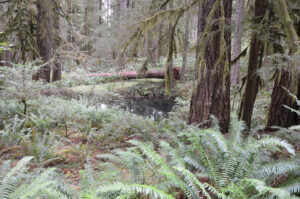
Oregon State University and the Department of State Lands agreed in February 2019 to produce a research and management plan for the Elliott State Forest by the end of that year. The proposed plan was supposed to focus on “key conservation values,” with the second “key value” being “a carbon sequestration program.”
Nearly five years later, in November 2023, OSU President Jayathi Murthy told the department that the university would be terminating its agreements regarding research and management of the Elliott. OSU said the primary reason for this decision was the university’s “significant concerns” regarding the department’s “intent” to move forward with a scheme by the department to use the forest to store carbon and then sell credits instead of actively managing for jobs and income.
Murthy’s decision to terminate the agreement came just over a year after an August 2022 email from OSU’s Forestry Dean Thomas DeLuca to the department and the State Land Board listed several reasons why OSU opposed a carbon-crediting scheme. DeLuca said the credits would pose a “serious financial risk,” would increase the cost of managing the forest and that it would be difficult over the long term to meet the sales requirements.
Three days before Murthy’s decision to pull out of the agreement, the Department of State Lands circulated a confidential report that stated the Elliott might not qualify for the carbon market – and even if it did, credits would likely generate less than $1 million per year and 20% of that amount would go to administering the program.
Nevertheless, the department recently announced plans to continue their efforts to sell carbon credits rather than logs from the Elliott.
The Elliott grows about 70 million board feet of timber a year and has a well-documented history of catastrophic wildfires, windstorms, floods and landslides. Less than 1% of the forest is old growth, more than 40,000 acres are in industrial plantations and the remainder is made up of mature trees grown following major wildfires in 1868 and 1879.
From 1960 until 1990, the Elliott sold 50 million board feet of timber a year, producing hundreds of millions of dollars for Oregon schools and more than 400 rural taxpaying jobs. There also were no wildfires during that time. Since the Department of State Lands took over management in 2017, the forest has lost more than a million dollars a year and only funded two road maintenance jobs, with an ever-increasing likelihood of catastrophic wildfires due to the increasing amount of unmanaged fuels growing every year.
An example of the ephemeral nature of carbon sequestration related to the sale of carbon credits is shown by the active Shelly Fire in northern California, which has burned more than 15,500 acres. A July 19 report about the fire included a map that outlined 11,000 acres of burned forest owned by Ecotrust Forest Management in Portland that had been used to sell carbon credits.
So, what happens next? Will money be returned to investors? Will the dead trees be salvaged or left in place to rot or burn again?
These are key questions that need to be considered and that the Department of State Lands hasn’t answered, according to Oregon State University.
The plan to sell carbon credits from the Elliott trees has already resulted in a significant amount of time and cost to Oregon taxpayers. Yet, there are no indications that carbon markets are stable, and even if credits could be sold, their value would be very low in comparison to traditional timber sales. The Elliott was created to help fund schools through timber sales and as a working forest. For two generations, it has done both and could continue to do so but not by selling carbon credits.
“An example of the ephemeral nature of carbon sequestration related to the sale of carbon credits is shown by the active Shelly Fire in northern California, which has burned more than 15,500 acres. A July 19 report about the fire included a map that outlined 11,000 acres of burned forest owned by Ecotrust Forest Management in Portland that had been used to sell carbon credits.”
Of note, that particular tract of forest was intensively high graded in the previous century by the first industrial landowner. Upon its sale a couple decades ago to a new industrial landowner, they realized they had been sold a bad bill of goods, and high graded the land further before selling to EFM. All local knowledge in the timber region of Siskiyou County California.
The new landowner very proactively initiated ecological thinning of small diameter trees, mastication of ladder fuels, and creation of road and ridge top fuel breaks. It was a far cry from passive forest management, and actually did create a lot of jobs in the local area. The burn severity within ownership, viewed within the USFS BAER Team burn severity data, indicates a very mixed severity patchy wildfire.
The Shelly Fire most likely resulted from a PCT hiker abandoning a campfire. It started on a day with zero clouds in the sky, in a remote are accessible only by the PCT, or a very long hike through the EMF ownership. The real culprit on the Shelly Fire isn’t carbon credits or a landowner willing to actively restore a forest while trying to make a few dollars from it, it was from careless ignorant humans in the forest, and ever expanding type of wildlife.